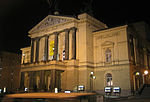Natural History Museum, Prague

Natural History Museum (Czech: Přírodovědecké muzeum) in Prague is one of the five components of the National Museum and currently consists of eight departments: the Mineralogical and Petrological, Paleontological, Mycological, Botanical, Entomological, Zoological, Anthropological, and the Ringing Station. The Museum of Natural History employs over 80 people, and its collections contain more than 15 million objects, of which only a fraction are exhibited. Ivo Macek has been the director of the museum since 2015.The museum's activities fulfill three main tasks: It expands and manages natural history collections and continuously documents nature not only in the Czech Republic Scientifically processes the collections and organizes its own research at the international level Presents its own collections and scientific activities to the general public through expositions, exhibitions, popular educational publications, lectures, accompanying programs to expositions and exhibitions, etc. It also involves the public in scientific research through citizen science projects.
Excerpt from the Wikipedia article Natural History Museum, Prague (License: CC BY-SA 3.0, Authors, Images).Natural History Museum, Prague
Wenceslas Square, Prague New Town
Geographical coordinates (GPS) Address Phone number Website Nearby Places Show on map
Geographical coordinates (GPS)
| Latitude | Longitude |
|---|---|
| N 50.078831 ° | E 14.430797 ° |
Address
Národní muzeum
Wenceslas Square 68
110 00 Prague, New Town
Prague, Czechia
Open on Google Maps









